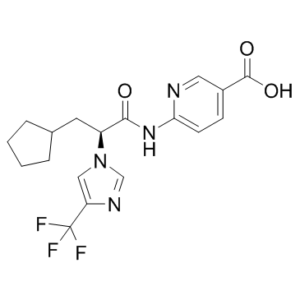PF-04991532
This product is for research use only, not for human use. We do not sell to patients.

For small sizes, please check our retail website as below: www.invivochem.com
| Size | Price | Stock |
|---|---|---|
| 100mg | $1150 | Check With Us |
| 250mg | $1700 | Check With Us |
| 500mg | $2550 | Check With Us |
Cat #: V4556 CAS #: 1215197-37-7 Purity ≥ 98%
Description: PF-04991532 is a novel, potent, hepatoselective glucokinase activator with EC50 of 80 and 100 nM in human and rat, respectively.
Top Publications Citing Invivochem Products
Publications Citing InvivoChem Products
Product Promise

- Physicochemical and Storage Information
- Protocol
- Related Biological Data
- Stock Solution Preparation
- Quality Control Documentation
| Molecular Weight (MW) | 396.36 |
|---|---|
| Molecular Formula | C18H19F3N4O3 |
| CAS No. | 1215197-37-7 |
| Storage | -20℃ for 3 years in powder formr |
| -80℃ for 2 years in solvent | |
| SMILES Code | O=C(O)C1=CN=C(NC([C@@H](N2C=C(C(F)(F)F)N=C2)CC3CCCC3)=O)C=C1 |
| Synonyms | PF-04991532; PF 04991532; PF04991532; PF-4991532; PF4991532; PF 4991532 |
| Protocol | In Vitro | PF-04991532 is a potent, hepatoselective glucokinase activator with EC50s of 80 nM in human and 100 nM in rat and also a Phase 2 clinical candidate. Mechanistic experiments conducted in freshly isolated primary rat hepatocytes treated for 1 hour with PF-04991532 show increased 2-[14C]-deoxyglucose uptake (EC50 =1.261 µM) and increased glucose oxidation (EC50=5.769 µM). Additionally, PF-04991532 decreases the production of glucose from 1-[14C]-lactate in a dose dependent manner (EC50 =0.626 µM). In isolated rat hepatocytes, PF-04991532 increases the expression of G6Pase compare to cells treated only with 100 nM glucagon, and the greatest increase in G6Pase mRNA expression is in the presence of 25 mM glucose, 100 nM glucagon and PF-04991532. |
|---|---|---|
| In Vivo | A single dose of PF-04991532 increases the glucose infusion rate in order to maintain hyperglycemia. Despite the elevations in plasma triglycerides, surprisingly, hepatic triglycerides in rats dosed with 19 days of PF-04991532 are identical to vehicle treated GK rats. In an additional cohort treated for 28 days, identical hepatic lipid concentrations are observed between vehicle and rats dosed with PF-04991532 (Vehicle: 9.89±0.31; PF-04991532 100 mg/kg: 9.91±0.31). In rats treated with PF-04991532, there is increased expression of lipogenic gene expression such as acetyl-CoA carboxylase (ACC), ATP citrate lyase (ACLY), and fatty acid synthase (FAS). |
These protocols are for reference only. InvivoChem does not
independently validate these methods.
| Solvent volume to be added | Mass (the weight of a compound) | |||
|---|---|---|---|---|
| Mother liquor concentration | 1mg | 5mg | 10mg | 20mg |
| 1mM | 2.5230 mL | 12.6148 mL | 25.2296 mL | 50.4592 mL |
| 5mM | 0.5046 mL | 2.5230 mL | 5.0459 mL | 10.0918 mL |
| 10mM | 0.2523 mL | 1.2615 mL | 2.5230 mL | 5.0459 mL |
| 20mM | 0.1261 mL | 0.6307 mL | 1.2615 mL | 2.5230 mL |
The molarity calculator equation
Mass(g) = Concentration(mol/L) × Volume(L) × Molecular Weight(g/mol)
Mass
=
Concentration
×
Volume
×
Molecular Weight*
The dilution calculator equation
Concentration(start)
×
Volume(start)
=
Concentration(final)
×
Volume(final)
This equation is commonly abbreviated as: C1 V1 = C2 V2
Concentration(start)
C1
×
Volume(start)
V1
=
Concentration(final)
C2
×
Volume(final)
V2
Step One: Enter information below
Dosage mg/kg
Average weight of animals g
Dosing volume per animal µL
Number of animals
Step Two: Enter the in vivo formulation
%DMSO
+
%
+
%Tween 80
+
%ddH2O
Calculation Results:
Working concentration:
mg/ml;
Method for preparing DMSO master liquid:
mg
drug pre-dissolved in
µL
DMSO(Master liquid concentration
mg/mL)
,Please contact us first if the concentration exceeds the DMSO solubility of the batch of drug.
Method for preparing in vivo formulation:
Take
µL
DMSO master liquid, next add
µL
PEG300, mix and clarify, next add
µL
Tween 80,mix and clarify, next add
µL
ddH2O,mix and clarify.
Note:
- (1) Please be sure that the solution is clear before the addition of next solvent. Dissolution methods like vortex, ultrasound or warming and heat may be used to aid dissolving.
- (2) Be sure to add the solvent(s) in order.




































